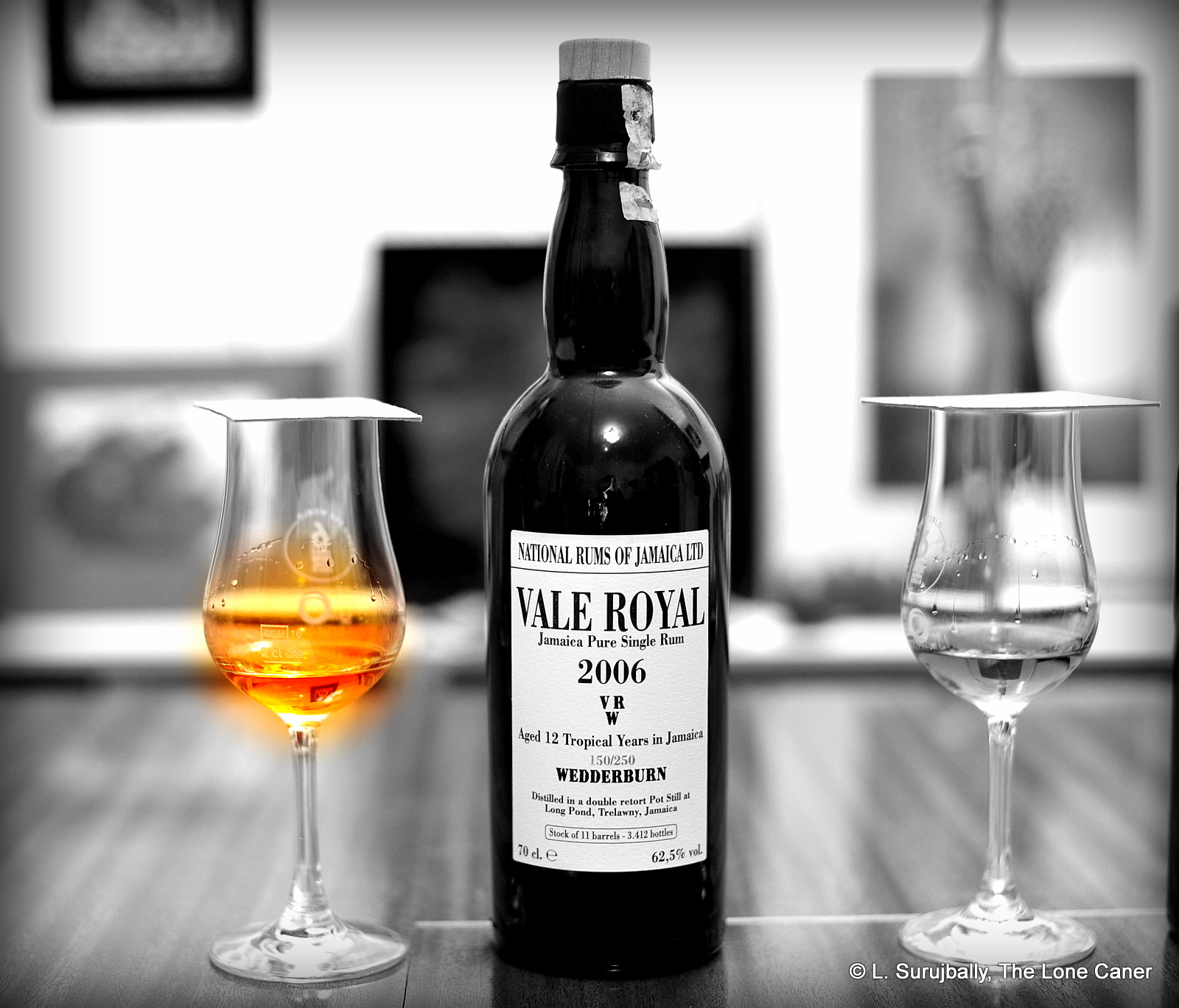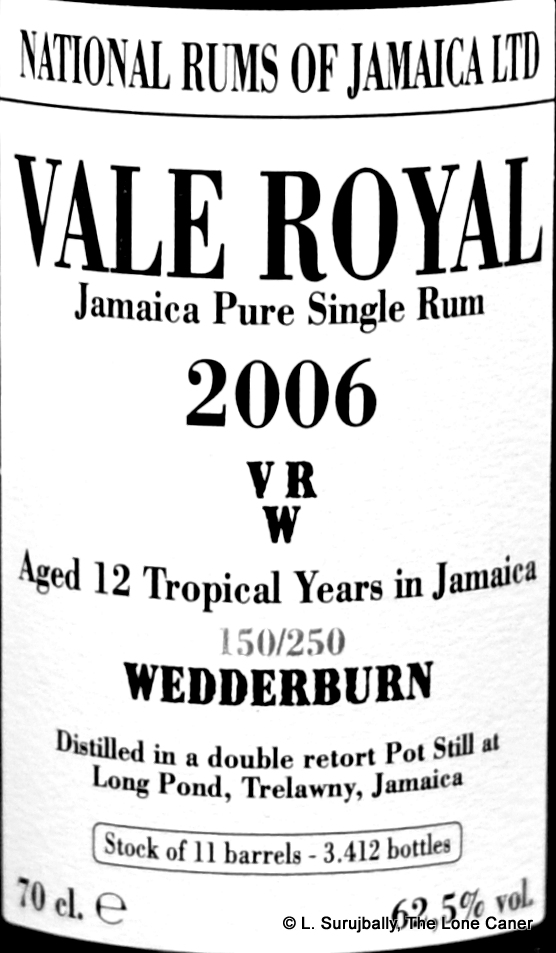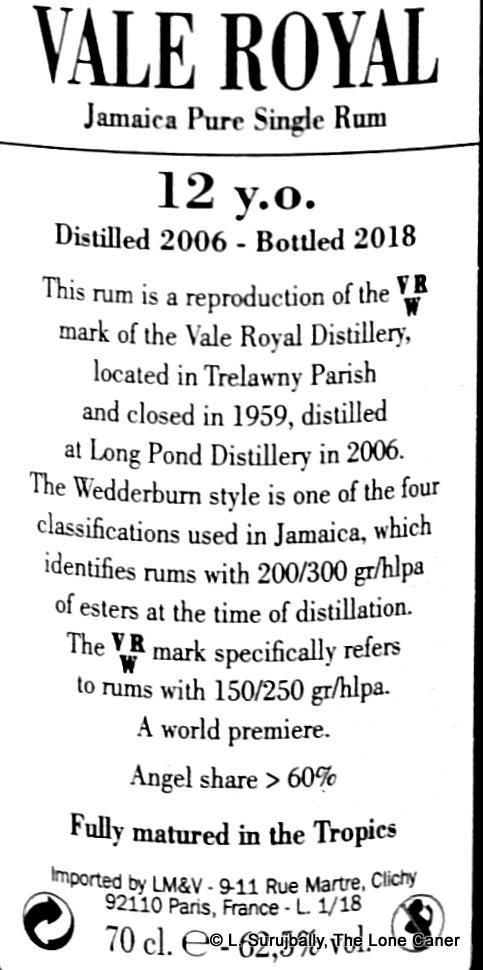
This whole week I’ll be looking at the quartet of stern, forbidding black and white bottles of the National Rums of Jamaica, which have excited a slowly rising conversation on social media as pictures get posted and more and more people try them. Certainly, they’ve got all the Jamaican rum punditry in transports already (plus they are issued by Velier, which is clear from the minimalist label and box design). All four will be written about in a sequence, because there’s simply no way to speak to them individually at long intervals without missing the point, which is that they’re part of an integrated set, and to understand one means to try and understand all – each informs the other. Because there’s a fair bit of background involved in these rums, below each post will have a longer-than usual “Background notes” section detailing notes common to all, and defining some terms, below the review.
The Vale Royal is probably the most traditional rum of the NRJ series, and for the reasonably wide-tasting rum drinker, the best one to start with, as will become clear when we move through the four-rum series. It also has the lowest ester-count among the set, which might give you an inkling of how they all progress (you’d think that….but no). Bottled at 62.5%, as they all are, it derives from a double retort pot still, is 12 years old, tropically aged (of course) and is made in the Wedderburn style, with an ester count of 150 grams per hectoliter of pure alcohol (g/hlpa) — out of a max of 250 for this classification — which is not the standard accepted one for Jamaicans as a whole, but Longpond’s own. That makes it a very approachable rum, very tasty, yet paradoxically not entirely a rum I could immediately assign to Jamaica, the way one could, for example, a Worthy Park, an Appleton, or a Hampden — though admittedly we have more experience with those and therefore know them somewhat better (this is a personal opinion, though).
 Consider first the nose. Frankly, I thought it was lovely – not just because it was different (it certainly was), but because it combined the familiar and the strange in intriguing new ways. It started off dusty, musky, loamy, earthy…the sort of damp potting soil in which my wife exercises her green thumb. There was also a bit of vaguely herbal funk going on in the background, dry, like a hemp rope, or an old jute sack that once held rice paddy. But all this was background because on top of all that was the fruitiness, the flowery notes which gave the rum its character – cherries, peaches, pineapples, mixed with salt caramel, vanilla, almonds, hazelnuts and flambeed bananas. I mean, that was a really nice series of aromas.
Consider first the nose. Frankly, I thought it was lovely – not just because it was different (it certainly was), but because it combined the familiar and the strange in intriguing new ways. It started off dusty, musky, loamy, earthy…the sort of damp potting soil in which my wife exercises her green thumb. There was also a bit of vaguely herbal funk going on in the background, dry, like a hemp rope, or an old jute sack that once held rice paddy. But all this was background because on top of all that was the fruitiness, the flowery notes which gave the rum its character – cherries, peaches, pineapples, mixed with salt caramel, vanilla, almonds, hazelnuts and flambeed bananas. I mean, that was a really nice series of aromas.
On the palate the strength showed its fangs and let’s face it, at 62.5% it’s got monster power hidden under the hood, and a little patience was required. It was sharp, sweet, flowery and estery to a fault, and somehow that dry earthy note disappeared almost entirely, probably edged out by the sheer force of all the other flavours that took over – this is perhaps one of those rums where a little water is really required. I didn’t get much without the addition, but with a few drops there was a cloudburst of flowery flavours and sharp fruits: pears, apples, cider, green grapes, raisins, unripe mangoes, tart yoghurt and sour cream, nuts, vanilla, anise and even some yeasty bread just to shake things up. And the finish, well, that was excellent – long, flavourful, fruity, sweetly flower-like, and took forever to die down, coughing up a last note of bitter chocolate, crushed hazelnuts, vanilla and sharp unripe fruits just to show that even on the back end it meant business and had a bit ore to smack you down with..
For my money, this is a pretty great rum. It is well aged, well balanced, and has the funky note and that fruity estery profile – neither to excess – that drives lovers of Worthy Park and Hampden into orgasmic throes of onanistic ecstasy. It also has originality and character in that it isn’t afraid to add a few extra things into the mix that might seem startling at first – these are new and original and yet not overdone. In fine, it has almost everything I want from a rum that purports to break the mould and show us something different – old tastes combined with new and intriguing flavours that somehow don’t call that much attention to themselves, all put together into something peculiarly its own. What it presented was an interesting melange of both Jamaican and something else, with a sly wink and an arrow pointing at the other, more ester-boosted rums in the series…for both good and ill. And that will become clearer as we progress through the line.
(#563)(87/100)
Background notes
(With the exception of the estate section, all remarks here are the same for the four reviews)
This series of essays on the four NRJ rums contains:
- NRJ Vale Royal 2006 12 YO VRW (11 barrels, 3412 bottles) 150/250 esters level
- NRJ Cambridge 2005 13 YO STC❤E (11 barrels, 3648 bottles) 550/700 esters level
- NRJ Long Pond 2003 15 YO TECA (9 barrels, 2484 bottles) 1200/1300 esters level
- NRJ Long Pond 2007 11 YO TECC (11 barrels, 3325 bottles), 1500/1700 esters level + summary
In brief, these are all rums from Long Pond distillery, and represent distillates with varying levels of esters (I have elected to go in the direction of lowest ester count → highest, in these reviews). Much of the background has been covered already by two people: the Cocktail Wonk himself with his Jamaican estate profiles and related writings, and the first guy through the gate on the four rums, Flo Redbeard of Barrel Aged Thoughts, who has written extensively on them all (in German) in October 2018. As a bonus, note that a bunch of guys sampled and briefly reviewed all four on Rumboom (again, in German) the same week as my own reviews came out, for those who want some comparisons.
 The various Jamaican ester marks
The various Jamaican ester marks
These are definitions of ester counts, and while most rums issued in the last ten years make no mention of such statistics, it seems to be a coming thing based on its increasing visibility in marketing and labelling: right now most of this comes from Jamaica, but Reunion’s Savanna also has started mentioning it in its Grand Arôme line of rums. For those who are coming into this subject cold, esters are the chemical compounds responsible for much of a given rum’s flowery and fruity flavours – they are measured in grams per hectoliter of pure alcohol, a hectoliter being 100 liters; a light Cuban style rum can have as little as 20 g/hlpa while an ester gorilla like the DOK can go right up to the legal max of 1600 at which point it’s no longer much of a drinker’s rum, but a flavouring agent for lesser rums. (For good background reading, check out the Wonk’s work on Jamaican funk, here).
Back in the day, the British classified Jamaican rums into four major styles, and many estates took this a few steps further by subdividing the major categories even more:
Standard Classification
- Common Clean 50-150 gr/hlpa
- Plummer 150-200 gr/hlpa
- Wedderburn 200-300 gr/hlpa
- Continental Flavoured 700-1600 gr/hlpa
Exactly who came up with the naming nomenclature, or what those names mean, is something of a historian’s dilemma, and what they call the juice between 301 to 699 gr/hlpa is not noted, but if anyone knows more, drop me a line and I’ll add the info. Note in particular that these counts reflect the esters after distillation but before ageing, so a chemical test might find a differing value if checked after many years’ rest in a barrel
Long Pond itself sliced and diced and came up with their own ester subdivisions, and the inference seems to be that the initials probably refer to distilleries and estates acquired over the decades, if not centuries. It would also appear that the ester counts on the four bottles do indeed reflect Long Pond’s system, not the standard notation (tables.
RV 0-20
CQV 20-50
LRM 50-90
ITP /LSO 90-120
HJC / LIB 120-150
IRW / VRW 150-250
HHH / OCLP 250-400
LPS 400-550
STC❤E 550-700
TECA 1200-1300
TECB 1300-1400
TECC 1500-1600
The Estate Name:
Vale Royal was a distillery located in Trelawny Parish, just like Longpond, and has a history covered in great depth by BAT, here. The long and the short of it is that it was founded in 1776 under the name of “Walky Walk” (poetic,yes?) before being retitled Vale Royal in the early 1800s. The estate managed to survive after the abolition of slavery, but a combination of falling sugar prices and a movement of consolidation led to the sale of the estate to Longpond in 1959, with the marque of VRW remaining as a memento of its glory days when it stood for “Vale Royal Wedderburn” – though as noted above, this edition, produced at Longpond’s facilities, should rightly be called a Plummer under Standard Notation, since it has 150 g/hlpa, not the required 200-300, but evidently decided to go with its own system.
Note: National Rums of Jamaica is not an estate or a distillery in and of itself, but is an umbrella company owned by three organizations: the Jamaican Government, Maison Ferrand of France (who got their stake in 2017 when they bought WIRD in Barbados, the original holder of the share Ferrand now hold) and Guyana’s DDL.